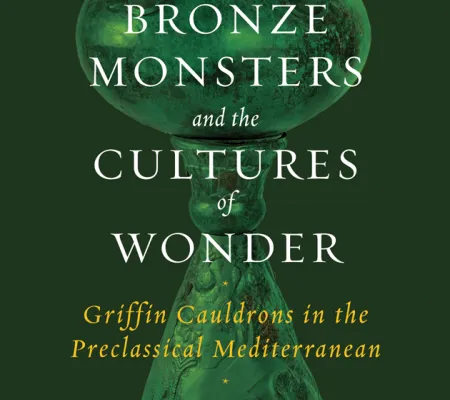Art History Associate Professor Nassos Papalexandrou has published a new book, Bronze Monsters and the Cultures of Wonder: Griffin Cauldrons in the Preclassical Mediterranean (UT Press, 2021). The book takes griffin cauldrons as case studies in the shifting material and visual universes of preclassical antiquity, arguing that they were perceived as lifelike monsters that introduced the illusion of verisimilitude to Mediterranean representational arts.
The eighth and seventh centuries BCE were a time of flourishing exchange between the Mediterranean and the Near East. One of the period’s key imports to the Hellenic and Italic worlds was the image of the griffin, a mythical monster that usually possesses the body of a lion and the head of an eagle.
In particular, bronze cauldrons bore griffin protomes—figurative attachments showing the neck and head of the beast. Crafted in fine detail, the protomes were made to appear full of vigor, transfixing viewers. The cauldrons were placed in the tombs of the wealthy (Italy, Cyprus) and in sanctuaries (Greece), creating fantastical environments akin to later cabinets of curiosities. Yet griffin cauldrons were accessible only to elites, ensuring that the new experience of visuality they fostered was itself a symbol of status. Focusing on the sensory encounter of this new visuality, Papalexandrou shows how spaces made wondrous fostered novel subjectivities and social distinctions.
Papalexandrou’s first book, The Visual Poetics of Power: Warriors, Youths, and Tripods in Early Greece, was published in 2005. Other ongoing projects include research on Greek antiquities exchanged as diplomatic gifts between Greece and the USA after WWII; the publication of Early Iron Age bronze finds from the sanctuary of Itonia Athena in Thessaly, Greece; and the collecting practices of Greek Geometric Art after WWII. Papalexandrou has recently held fellowships at the Center of Advanced Studies in the Visual Arts, National Gallery, Washington D.C. and at the American School of Classical Studies at Athens Greece. In 2018–2019, he is a collaborator in “Material Entanglements in the Ancient Mediterranean and Beyond,” a research project funded by the Getty Foundation through its Connecting Art Histories initiative which meets in Athens under the auspices of Johns Hopkins University and the National Hellenic Research Foundation in Athens.


